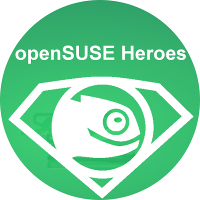The openSUSE.org official infrastructure is getting bigger and complicateder, so #microservices and #serverless FTW! ![]()
![]()
![]()

This project will try to finish the ongoing effort to set up k8s and Cloud Foundry in the openSUSE.org infrastructure, using the SUSE products CaaSP and CAP. The end goal would be to have a fully working PaaS environment, ready to accept static pages for starters, eg static.opensuse.org.
P.S. If no native solution for storageclass for our current storage will be found, then a SES installation will also be performed.
#hackweek #susehackweek #hackweek17 #susecz #cz #prague #k8s #kubernetes #cloudfoundry #opensuse #heroes #opensuseheroes #caasp #cap
Looking for hackers with the skills:
k8s kubernetes cloudfoundry opensuse heroes opensuseheroes caasp cap microservices serverless
This project is part of:
Hack Week 17
Activity
Comments
-

about 7 years ago by hennevogel | Reply
hey @agraul would you be willing to help out with the SES part?
-

-

about 7 years ago by tampakrap | Reply
Small status report:
We have working dashboards: - https://caasp-admin.infra.opensuse.org (caasp-admin) - https://k8sdashboard.infra.opensuse.org (kubernetes UI) - https://stratos.infra.opensuse.org (cloudfoundry UI)
On top of that we have plenty of apps deployed internally: - https://hellocf.cf.infra.opensuse.org - https://html5test-caasp.cf.infra.opensuse.org - https://static-caasp.cf.infra.opensuse.org - https://studioexpress-caasp.cf.infra.opensuse.org - https://software-caasp.cf.infra.opensuse.org
... and publicly: - https://hellocf.opensuse.org - https://html5test-caasp.opensuse.org - https://static-caasp.opensuse.org - https://studioexpress-caasp.opensuse.org - https://software-caasp.opensuse.org (this one being the most important achievement, as it required also memcached set up which we managed to do also successfully)
For future steps please visit our Geekops Trello board
-

about 7 years ago by tampakrap | Reply
A write-up at the openSUSE Heroes blog: https://progress.opensuse.org/news/68
Similar Projects
This project is one of its kind!